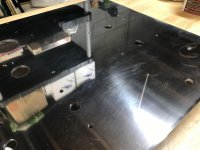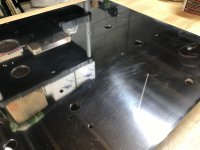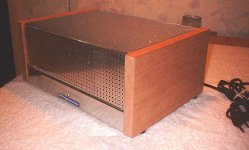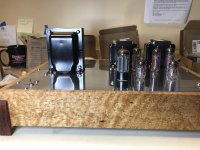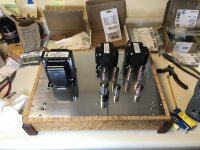I am building a tube amp with wood sides and aluminum top plate. I have sanded to 2000 grit paper and then polished to a shine. The shine always shows scratches in the direction of my polishing is it possible that some aluminum will never polish all the way out?
I am not 100% sure, I believe your scratches are deeper than the grit on the 2000 paper. I think you have to go up in smaller steps on grit ie 220 300 400 600 1000 2000 polish etc.
I removed scratches on our black enameled fridge by using 600 wet, 1000, wet, 2000 wet then a car buffing compound. The area that I worked on was now smoother than the rest of the fridge.
when finishing wood, I end up with 600 wet and then polish with "Behlen's Rottenstone" an extremely fine powder. This leaves a mirror finish.
remember to sand in one direction.
I removed scratches on our black enameled fridge by using 600 wet, 1000, wet, 2000 wet then a car buffing compound. The area that I worked on was now smoother than the rest of the fridge.
when finishing wood, I end up with 600 wet and then polish with "Behlen's Rottenstone" an extremely fine powder. This leaves a mirror finish.
remember to sand in one direction.
Aluminum, if not anodized, oxidizes and as a result darkens over time. To maintain a mirror finish, some sort of protective coating would be needed.
In addition to starting around 220 grit of silicon carbide (black) paper and increasing the grit by 1.5 times per step, you need to wipe the residue off the plate between grits. My eye leads me to believe while getting to polishing grits you hand bits of much larger stuff still on the plate.
I use circular motions and have only problems with how long it takes. I just did a bit of Damascus steel and it took an hour a day for months to get it to a mirror finish.
I use circular motions and have only problems with how long it takes. I just did a bit of Damascus steel and it took an hour a day for months to get it to a mirror finish.
Last edited:
I've polished aluminum plate and it's plain to see that you never got the scratches out from previous grit sandpaper. For a large surface like that use a sanding block as well. Maybe go back to 1000 grit and work it for a bit. Hit it with something like Mothers aluminum polish and give it a quick buff. All the sanding marks will pop, do you see anything that stands out? If so, go back to the 1000 grit and try again.
Rinse and repeat. When it's perfectly uniform go up to the next grit.
For protection of a polished finish a good car wax will keep oxidation at bay for quite some time.
BillWojo
Rinse and repeat. When it's perfectly uniform go up to the next grit.
For protection of a polished finish a good car wax will keep oxidation at bay for quite some time.
BillWojo
Hand buffing will never amount to a "perfect" polished finish.
I can see the curved strokes in those photos.
A motorized buffing wheel with the proper polishing paste is better at having a more "straight line" finish.
Ya run the piece under the wheel with a straight fence to eliminate the chances of "wobble".
I've finished with a good wipe-down by using what's called a Miracle Cloth to lay down a protective anti-tarnish finish.
15 years later, the front facade still looks nice...
I can see the curved strokes in those photos.
A motorized buffing wheel with the proper polishing paste is better at having a more "straight line" finish.
Ya run the piece under the wheel with a straight fence to eliminate the chances of "wobble".
I've finished with a good wipe-down by using what's called a Miracle Cloth to lay down a protective anti-tarnish finish.
15 years later, the front facade still looks nice...
Attachments
Last edited:
Also, when you get up around 1200, it’s a good idea to cut the corners of the paper round, to avoid the pointy corners scratching.
I also use an alternating slight angle so as not to go completely I one direction, but definitely no circular motions.
I also use an alternating slight angle so as not to go completely I one direction, but definitely no circular motions.
Meguiar's makes their Unigrit sheet abrasive up to 3000 grit, and 3M Trizact products go past 3000. Try those if you are really having trouble with getting a fine sanded finish, and make sure you end with a suitable aluminum polish.
Someone else has mentioned to clean the surface between grits. That's important too, along with making sure the scratches from the previous grit are completely (COMPLETELY) gone before moving to the next finer grit.
Someone else has mentioned to clean the surface between grits. That's important too, along with making sure the scratches from the previous grit are completely (COMPLETELY) gone before moving to the next finer grit.
There is a reason why nearly everything in the world has a directional scratch pattern to it. You can scratch “polished” stainless steel almost from looking at it. Extremely frustrating work. When doing it for a living we discovered that it took 10x the effort, but customers only wanted to pay 2x what it cost to do a nice directional or semi-random scratch pattern. It did not take long as a student before I refused to entertain highly polished surfaces just as the master had done years before. Occasionally they’re called for but outside of rare circumstances they’re a fool’s errand. Electropolishing might be an option, though I don’t know how/whether it works for aluminum.
Can you chrome plate aluminum? I have not looked into this. It would surely be more durable and long lasting than polished raw aluminum.
Can you chrome plate aluminum? I have not looked into this. It would surely be more durable and long lasting than polished raw aluminum.
A mirror finish means that the surface must be mirror flat. I learned this the hard way and ended up going back to a 220 grit finish using an orbital sander.
Thank you all for the time and advise! I finalized with what I call controlled scratching my water here is hard and I found some minerals must get thru and can wreak havoc Here are some pics
Attachments
Nice work, rock12.
However, if that octal tube is a rectifier, why is it so near the input tubes?
I would have mounted it closer to the PT, with the PT mounted in line with the OTs.
However, if that octal tube is a rectifier, why is it so near the input tubes?
I would have mounted it closer to the PT, with the PT mounted in line with the OTs.
- Home
- Design & Build
- Construction Tips
- Mirror finish on aluminum
